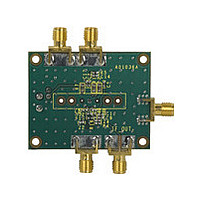AD8342-EVAL Analog Devices Inc, AD8342-EVAL Datasheet - Page 17

AD8342-EVAL
Manufacturer Part Number
AD8342-EVAL
Description
Manufacturer
Analog Devices Inc
Datasheet
1.AD8342-EVAL.pdf
(24 pages)
Specifications of AD8342-EVAL
Lead Free Status / Rohs Status
Not Compliant
The AD8342 is optimized for driving a 100 Ω load. Although
the device is capable of driving a wide variety of loads, to
maintain optimum distortion and noise performance, it is
advised that the presented load at the IF outputs is close to
100 Ω. The linear differential voltage conversion gain of the
mixer can be modeled as
where:
R
g
R
The external R
dissipation and dynamic range of the AD8342. Because the
AD8342 has internal resistive degeneration, the conversion gain
is primarily determined by the load impedance and the on-chip
degeneration resistors. Figure 49 shows how gain varies with IF
load. The external R
most direct way to affect conversion gain is by varying the load
impedance. Small loads result in lower gains while larger loads
increase the conversion gain. If the IF load impedance is too
large, it causes a decrease in linearity (P1dB, IP3). In order to
maintain positive conversion gain and preserve SFDR
performance, the differential load presented at the IF port
should remain in the range of about 100 Ω to 250 Ω.
G
m
LOAD
e
m
= 15 Ω.
is the transistor transconductance and is equal to 1810/R
=
A
is the single-ended load impedance.
AD8342
V
1
π
COMM
COMM
×
IFOM
=
IFOP
Figure 47. Biasing the IF Port Open-Collector Outputs
Figure 48. Biasing the IF Port Open-Collector Outputs
1
G
Using a Center-Tapped Impedance Transformer
+
m
AD8342
g
g
8
7
6
5
BIAS
×
COMM
COMM
m
m
IFOM
IFOP
R
R
resistor is used to control the power
LOAD
e
Using Pull-Up Choke Inductors
BIAS
8
7
6
5
resistor has only a small effect. The
2:1
TRANSFORMING
IMPEDANCE
NETWORK
Z
L
BIAS
Rev. A | Page 17 of 24
.
LO CONSIDERATIONS
The LOIN port provides a 50 Ω load impedance with common-
mode decoupling on LOCM. Again, common-grade ceramic
capacitors provide sufficient signal coupling and bypassing of
the LO interface.
The LO signal needs to have adequate phase noise characteristics
and low second-harmonic content to prevent degradation of the
noise figure performance of the AD8342. An LO plagued with
poor phase noise can result in reciprocal mixing, a mechanism
that causes spectral spreading of the downconverted signal,
limiting the sensitivity of the mixer at frequencies adjacent to
any large input signals. The internal LO buffer provides enough
gain to hard-limit the input LO and provide fast switching of
the mixer core. Odd harmonic content present on the LO drive
signal should not impact mixer performance; however, even-
order harmonics cause the mixer core to commutate in an
unbalanced manner, potentially degrading noise performance.
Simple lumped element low-pass filtering can be applied to help
reject the harmonic content of a given local oscillator, as shown
in Figure 50. The filter depicted is a common 3-pole Chebyshev,
designed to maintain a 1-to-1 source-to-load impedance ratio
with no more than 0.5 dB of ripple in the pass band. Other filter
structures can be effective as long as the second harmonic of the
LO is filtered to negligible levels, for example, ~30 dB below the
fundamental.
Figure 50. Using a Low-Pass Filter to Reduce LO Second Harmonic
30
25
20
15
10
5
0
10
Figure 49. Voltage Conversion Gain vs. IF Loading
C1 =
f
C
SOURCE
- FILTER CUTOFF FREQUENCY
LO
2π
1.864
f
c R
L
FOR R
C1
L2 =
R
S
IF LOAD (Ω)
S
1.28R
= R
2π
L2
100
C3
f
L
c
L
LOCM
C3 =
2
AD8342
R
MODELED
LOIN
L
2π
1.834
3
f
c R
COMM
L
MEASURED
4
AD8342
1000










